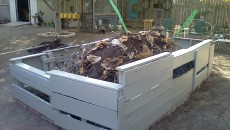By Aaron de Leon
LatinaLista
Standing in a spectacular back yard in beautiful Austin, Texas, I am captivated by the energy permeating from the well-though-out landscape. To my left, a traditional, seasonal vegetable garden proudly contributes an assortment of fresh tomatoes, peppers and onions to the Farmist yield. Directly in front of me, stands a chicken coop expertly fashioned from reclaimed wood and metal.
Paintings, sculptures, painted trees and chickens fill the space between monuments. To my immediate right sits a seemingly out of place mound of garbage. Or is it tree limbs? A compost? My curiosity pitches high.
My older brother, Joseph de Leon is the proud owner and constructor of this urban farm. Soaking in the energy of back yard art, chickens and produce, my curiosity reaches maximum velocity when I finally ask, “What is this mound?” “Hugelkutur,” he replied. “A what?” I asked again. “Hugelkultur. It’s a type of raised bed garden,” he said. I was mesmerized as he explained the process and purpose behind this ancient gardening method.
Hugelkultur is the German word for Mound Culture. Eastern European Farmists practiced mound culture for hundreds of years before Austrian Permaculture expert and Rebel Farmer, Sepp Holzer perfected its techniques. It is widely considered to be one of the most efficient and practical raised bed garden methods in practice today. Typical mounds are 3′ wide x 6′ long x 3′ high. Some Farmists prefer retaining walls to minimize mound erosion. Without retaining walls, experts suggest a 60-80 degree mound slope.
I asked him to describe the construction process. “The base layer of the Hugelkultur mound consists of a few layers of corrugated cardboard to create a semi-permeable barrier,” He said. This base layer will help retain water which is one of two core elements of Hugelkutur construction. The other is wood.
“Small partially rotted logs piled up at the base act as a sponge to hold water in the center of the mound,” he said. These partially rotted logs have a porous consistency like that of a sponge. As the spongy log material is stacked in a neat pile on top of the cardboard base, it is soaked with water.
A generous amount of organic material, such as leaves, saw dust and wood chips are placed on top of the log material and once again, soaked with water.
“Smaller branches and twigs stacked on top of the organic material provide a framework for soil to adhere to,” he said, “and provides spongy anchors for growing plant roots while keeping soil from compacting.”
Hugelkultur expertly replicates forest floor decomposition. When a tree falls in the forest, it rots among the organic material on the forest floor. The spongy, decaying wood absorbs rain water and the foundation for new life is created.
Lastly, “A mixture of soil, dead leaves, and green organic material,” he said, “jump starts the process that converts ‘trash’ into rich plant food.”
For more pictures and a detailed description of this Hugelkultur garden, visit Urban Farmist.
Featured Photo: Austin urban farmer, Joseph de Leon, pauses amid his chores in his backyard urban farm.




